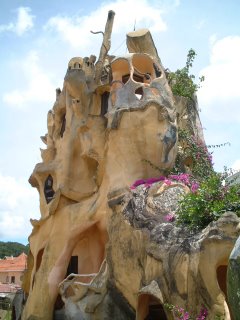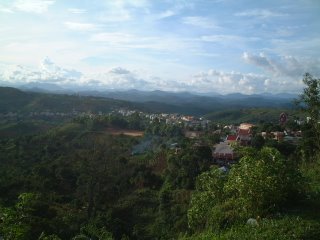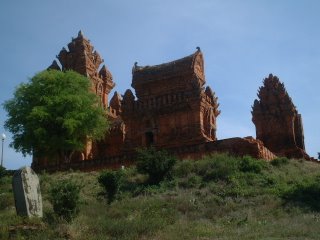Delicious Dalat









Dalat, 3670 km
It's a grey but exquisitely cool day here in the highland town of Dalat, and I am relieved and reinvigorated by the escape from the tremendous sweltering heat and humidity of the coast. I rode up yesterday in the longest and toughest day of the entire trip (2700 vertical metres over 110 km), and although I arrived tired, I was also exultant at having escaped the endless grey ugliness of National Route 1A. It has done my soul a universe of good to have ridden all day on a quiet road through pine forests and to have gotten great views of a pretty landscape.
Two days ago I rode out of Nha Trang hoping to have a big day, to reduce the length of the day to Dalat. Alas, it was not to be. It was, of course, very hot and humid, but I'm used to that now, psychologically if not physiologically. The problem was the wind, which kicked up before lunch and was blowing a full gale by mid-afternoon, reducing progress to a frustrating, soul-sapping crawl. I had planned to reach the city of Phan Ram by about 2, spend an hour exploring its Cham towers, and then ride several hours towards Dalat. Instead, it was 4:30 by the time I struggled into Phan Ram, and with only an hour and a half of daylight left, I decided to cut my losses and put up in Phan Ram. It was surprisingly hard to find a hotel; the first two I found wanted ridiculous sums, and one of them had an explicit twin-pricing policy, with foreigners paying 35% more than Vietnamese. Since being ripped off is not my favourite part of travel in Vietnam, I kept hunting until I found a little mini-hotel for $6 (cheap by inflated Vietnamese standards). I had a good evening, eating a smorgasbord of street food and banh xeo, the shrimp pancakes I have grown to love. I ran into two Ukrainian aircraft engineers working in Phan Ram (there seems to be a lot of military aircraft flying in the Phan Ram skies) and chatted to them in Russian for a while, to the bemusement of the local Vietnamese.
Yesterday I awoke late (6:30, an hour after sun-up) and paid the price later in the day. On the way out of town, I visited the Cham towers of Po Klong Girai, some of the most impressive surviving towers and still in use by the local Cham populace, impoverished and marginalized survivors of a culture that once dominated half of Vietnam. The towers were pretty heavily restored, but still had a magnificent dancing Shiva over the main doorway and had wonderfully ornate roofs. I was lucky; while the first tour bus of the day were arriving, I sat down and sketched the towers from a distance, and by the time I was done, their bus was departing. I prowled around to my heart's content completely alone on the hilltop, and just as I was leaving, the next tour bus arrived.
The first 50 km of riding were gently uphill on the coastal plain, and then it got serious, with 35 kilometres of steady climbing that topped out at 1550 metres elevation. Just when I thought the hard work was over, a roller coaster of a road undulated the last 25 km into town. I was racing the setting tropical sun, and I lost; it was well and truly dark by the time I got into the city, which made finding my way to a hotel a tricky proposition, not helped by the hallucinogenic street layout of this hilly city.
Today I explored a couple of the major sights of the town, after a lazy morning spent in bed reading The Ghost Road, a masterpiece by Pat Barker about WWI. I stopped into the Crazy House, quite possibly the strangest, most exuberant architectural folly in the world. Imagine Gaudi designing sets for Alice in Wonderland, or The Hobbit, and you get a flavour. It's supposed to be a hotel, designed by the daughter of Ho Chi Minh's successor as leader of Vietnam. The overall theme seems to be trees, and the whole structure is encased in a web of realistic-looking concrete branches, rather like a huge strangler fig has overwhelmed the house. Inside I don't think there is a single straight line in the building, as the architect allowed her imagination to run riot. The corridors and stairs meander drunkenly inside more concrete branches, while each room is named after a different natural item: ants, kangaroos, hornbills bamboo and the like. Beds, chairs, sofas and tables take on organic, irregular shapes that look amazing but might not be so good for lying or sitting on. The garden is full of avant-garde art and imitation spider's webs, outsized Russian babushka dolls and hobbit's houses. It's quite simply breathtaking, although kitschy at the same time. Perhaps the most amazing thing is that concrete can be moulded into such irregular, rounded shapes. Like all good follies, it's unfinished; like a miniature Sagrada Familia in that respect, as in others.
I also went to see the summer palace of Bao Dai, the last Emperor of Vietnam. Built in 1938, it retains all its original furnishings and fittings. I'm sure the furniture was the last word in taste at the time, but it has aged poorly, looking cheap and shoddy and like what you find at summer cottages in Canada. The bathrooms, too, make you realize how much taste in bathrooms has changed over the decades. Outside, a legion of Vietnamese dressed as cowboys, leopards, cartoon mice and a host of other creatures waited for the hordes of Vietnamese tourists to pay to have their pictures taken with them. It looked like a fairly depressing way to make a living. The biggest lineup, though, was to pay a dollar for the right to dress up as an 11th-century emperor in yellow silk robes and silk riding boots and be photographed.
So, since there are so few news updates to give, it's time for more thoughts that have accumulated under the mullet over the past few weeks.
Musings from Under a Mullet
The other day I counted how many motorcycles on the road here have only one person on them. From a sample size of 100, I arrived at a figure of less than 40%. So 60% of motorcycles on the road here have at least 1 passenger, and frequently quite a few more than that. I wonder how many babies, carried in their mother's arms, die by falling from the bike when it has to brake or swerve suddenly. It's nice, however, to see such efficient use of fuel. I'm sure the average Vietnamese has an ecological footprint that's tiny compared to mine.
On the topic of passengers on two-wheel conveyances, I saw a novelty the other day. Two schoolgirls were pedalling a bike together; the one on the seat pedalled only with her left foot, while the girl on the luggage rack handled the right pedal. Such an asymmetric arrangement cannot be comfortable, you would think. But bodily discomfort does not seem to faze the Vietnamese; you see them seated with all their weight supported on the crossbar of the bike. You try that sometime and see how much that hurts after a while. I saw an entire family of 5 on one bicycle the other day, which I think is my all-time record for people on a bike (other than the 13 I saw at the Beijing Circus).
Having been ripped off more times than I care to remember, it's the exceptions that stick in the mind, like the man who owned a cafe who gave me a free water because we'd had such a good conversation. It's very rare here to be given anything for free, unlike in Islamic countries, particularly in Central Asia, where there is a cult of hospitality to guests. Here in Vietnam, the only cult is that of the quickest and most bucks possible extracted from the stupid foreigner, which is already the universal reputation of Vietnam on the backpacker circuit.
As I move through the country, I'm amazed at the tremendous variety in facial types that I see here. I thought that most Vietnamese would look roughly Chinese, but, especially in the central and southern coastal areas, there's a lot of Malay-looking faces. Other places, in the mountains mostly, there are people who look Polynesian, with bigger noses and lips and strong cheekbones. It seems to me that Vietnamese culture has spread from north to south over the centuries without necessarily displacing the people, so that the great variety of indigenous tribes have been absorbed into Vietnamese society, giving it this tremendous diversity. I just wish that the great diversity of traditional tribal clothing that I saw in the northwest were to be seen everywhere, as it's easily the most interesting feature of modern Vietnam.
Looking at the role that the average male plays in Vietnamese society, you have to wonder why the women keep them around. I suppose you could argue that this is the case in most societies, but the average man here defines his virility and social utility by the 4 H's: Hondas, hookahs, hooch and hookers. While the women work in the kitchen and the fields, the men gather around to drink themselves silly (at 7 am!), to criticize the world over their bamboo water pipes, to drive around aimlessly on their motorbikes, or to patronize the local houses of ill-repute. It's not an edifying sight. I'm sure that the local men, seeing that I ride a bicycle, don't smoke, don't visit the brothels and have a solitary beer at the end of the day are convinced that I must not really be a man.
The women here are more muffled against the sun than anywhere I've ever seen. When women go out on their motorbikes in the 38-degree steam bath of midday, all you can see of them is a hint of the eyes. They're wearing sun hats, face masks and, if they have a short-sleeved blouse on, shoulder-length gloves, all in the name of keeping their skin as white as possible. It's amazing the lengths they'll go to; I saw a woman wearing a jacket over a turtleneck sweater the other day. I would die instantly of heatstroke if I had to wear that many layers. But people here don't seem to sweat at all; their sloth-like torpor for most of the day probably helps, but I sweat just sitting indoors. They are cut from sterner stuff.
It occurred to me the other day, in a blinding flash of insight, that the old French word for Vietnam, Laos and Cambodia, Indo-Chine, was a perfect description of this area. Geographically half-way between the two great cultural well-springs of Asia, Vietnam was always a frontier between the Indianized and Sinicized worlds. The north, around Hanoi, was part of China for 12 centuries, and the Vietnamese culture is deeply Chinese in its style: Confucian, Daoist and Mahayana Buddhist, not to mention using Chinese characters until 150 years ago. The centre and south looked to India for its culture, with the Funan and then the Cham importing Hinduism and Theraveda Buddhism, Indian alphabets and architecture. Some people see the victory of the north in the Vietnam War as the final victory for Sinicized culture over Indianized culture here. Whatever the case, I think as a tourist I find the Cham architecture and art to be far more interesting than the northern Vietnamese. Go India!
There's a principle in quantum mechanics that you can't observe the state of a system without altering the system in the process. This is a good metaphor for my effect on the typical Vietnamese roadside village. Before I arrive, life is continuing its placid usual pace. As soon as I heave onto the horizon, one excited shout alerts other people, and suddenly the village is alive with excited hollering, kids running, boys pursuing me on bikes, farmers turning around from their planting to have a good look at me. It means that if I want to take a photo of someone working in their fields (plowing with buffaloes is particularly photogenic), I have to work very fast before they're alerted by their neighbours and stop what they're doing to stare at me. I'm sure that it takes quite some time for the excitement to die down after I pass. I'm the Quantum Disturbance on Wheels.
I cannot for the life of me crack the southern Vietnamese accent. I'm having so much trouble communicating these days that I'm getting very frustrated. Even the phrase "how much does it cost?", which is "bao nieu" is not understood a lot of the time. It drives me mad, but of course the fault is my own, since I'm sure my accent and lack of tones does make me sound like a gibbering babboon to Vietnamese ears.
The other day, while talking to the two Ukrainians, I realized what one of the great annoyances of Vietnam is. Everyone absolutely shouts at each other, even when talking face to face. The Vietnamese who were discussing us some distance away drowned out our own attempts at conversation. The whole culture is remarkably immune to noise: loudspeakers, traffic, horns and the ever-present cacophony of karaoke. Rather like China in that respect, and a bit wearing on the nerves after a while.
My personal pet peeve here is the lack of change. As soon as I pay for something, the pantomime begins: looking in pockets, at the back of the cash drawer, in biscuit tins, in the kitchen. It's invariable; there are no small bills or coins to be found. Certain countries are like this: India, Indonesia and Uzbekistan spring to mind. The state of cash drawers here doesn't help in the search; rather than having bills sorted by denomination, there is a hopeless higgledy-piggledy mess of paper that is impossible to sort through efficiently. Third World is definitely a state of mind more than a state of poverty.
Well, off to watch the French Open tennis and the World Cup before setting off on the last 3 days of riding tomorrow morning. Hope everyone's busy seizing the day. Remember what Thoreau said: "As if you could kill time without injuring eternity! The mass of men lead lives of quiet desperation." So stop killing time by reading this blog and get back to living!
Tam Biet!

0 Comments:
Post a Comment
<< Home